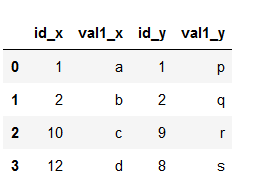Different Types of Joins in Pandas
Last Updated :
28 Aug, 2023
The Pandas module contains various features to perform various operations on Dataframes like join, concatenate, delete, add, etc. In this article, we are going to discuss the various types of join operations that can be performed on Pandas Dataframe. There are five types of Joins in Pandas.
- Inner Join
- Left Outer Join
- Right Outer Join
- Full Outer Join or simply Outer Join
- Index Join
To understand different types of joins, we will first make two DataFrames, namely a and b.
Dataframe a:
Python3
import pandas as pd
a = pd.DataFrame()
d = {'id': [1, 2, 10, 12],
'val1': ['a', 'b', 'c', 'd']}
a = pd.DataFrame(d)
a
|
Output:
DataFrame b:
Python3
import pandas as pd
b = pd.DataFrame()
d = {'id': [1, 2, 9, 8],
'val1': ['p', 'q', 'r', 's']}
b = pd.DataFrame(d)
b
|
Output:
Types of Joins in Pandas
We will use these two Dataframes to understand the different types of joins.
Pandas Inner Join
Inner join is the most common type of join you’ll be working with. It returns a Dataframe with only those rows that have common characteristics. This is similar to the intersection of two sets.
Example:
Python3
import pandas as pd
a = pd.DataFrame()
d = {'id': [1, 2, 10, 12],
'val1': ['a', 'b', 'c', 'd']}
a = pd.DataFrame(d)
b = pd.DataFrame()
d = {'id': [1, 2, 9, 8],
'val1': ['p', 'q', 'r', 's']}
b = pd.DataFrame(d)
df = pd.merge(a, b, on='id', how='inner')
df
|
Output:

Pandas Left Join
With a left outer join, all the records from the first Dataframe will be displayed, irrespective of whether the keys in the first Dataframe can be found in the second Dataframe. Whereas, for the second Dataframe, only the records with the keys in the second Dataframe that can be found in the first Dataframe will be displayed.
 Example:
Example:
Python3
import pandas as pd
a = pd.DataFrame()
d = {'id': [1, 2, 10, 12],
'val1': ['a', 'b', 'c', 'd']}
a = pd.DataFrame(d)
b = pd.DataFrame()
d = {'id': [1, 2, 9, 8],
'val1': ['p', 'q', 'r', 's']}
b = pd.DataFrame(d)
df = pd.merge(a, b, on='id', how='left')
df
|
Output:

Pandas Right Outer Join
For a right join, all the records from the second Dataframe will be displayed. However, only the records with the keys in the first Dataframe that can be found in the second Dataframe will be displayed.

Example:
Python3
import pandas as pd
a = pd.DataFrame()
d = {'id': [1, 2, 10, 12],
'val1': ['a', 'b', 'c', 'd']}
a = pd.DataFrame(d)
b = pd.DataFrame()
d = {'id': [1, 2, 9, 8],
'val1': ['p', 'q', 'r', 's']}
b = pd.DataFrame(d)
df = pd.merge(a, b, on='id', how='right')
df
|
Output:

Pandas Full Outer Join
A full outer join returns all the rows from the left Dataframe, and all the rows from the right Dataframe, and matches up rows where possible, with NaNs elsewhere. But if the Dataframe is complete, then we get the same output.

Example:
Python3
import pandas as pd
a = pd.DataFrame()
d = {'id': [1, 2, 10, 12],
'val1': ['a', 'b', 'c', 'd']}
a = pd.DataFrame(d)
b = pd.DataFrame()
d = {'id': [1, 2, 9, 8],
'val1': ['p', 'q', 'r', 's']}
b = pd.DataFrame(d)
df = pd.merge(a, b, on='id', how='outer')
df
|
Output:

Pandas Index Join
To merge the Dataframe on indices pass the left_index and right_index arguments as True i.e. both the Dataframes are merged on an index using default Inner Join.
Python3
import pandas as pd
a = pd.DataFrame()
d = {'id': [1, 2, 10, 12],
'val1': ['a', 'b', 'c', 'd']}
a = pd.DataFrame(d)
b = pd.DataFrame()
d = {'id': [1, 2, 9, 8],
'val1': ['p', 'q', 'r', 's']}
b = pd.DataFrame(d)
df = pd.merge(a, b, left_index=True, right_index=True)
df
|
Output:

Share your thoughts in the comments
Please Login to comment...